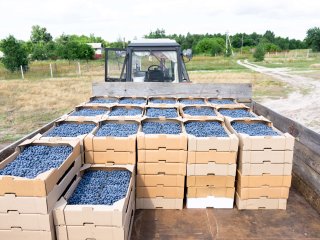
Transport practices for blueberries
The transport of fresh products like blueberries generally takes place in (refrigerated) trucks, reefer containers or by plane. Checks and proper loading are always important to maintain good (temperature) conditions for the product during transport. For fresh products, refrigerated transport is often necessary. Trucks and reefers can maintain a low temperature, but do not have enough cooling capacity to lower the product temperature. Therefore, products must be pre-cooled before entering the refrigerated truck or reefer. During transport and waiting periods, the load must be well covered to protect against dust, sun and rain. Careful driving and careful product handling is essential to prevent damage to products due to mechanical action.

Optimal transport conditions
Blueberries are packed in open boxes or crates on the farm or packhouse in close distance to the farm. Timely transport to the farm or packhouse with pre-cooling facility is necessary as quickly obtaining a low temperature is essential for the keeping quality of blueberries. Pre-cooling of the product, usually to a temperature between 0 and 0.5 ºC, is absolutely necessary before the product enters the refrigerated truck for further transport. Blueberries for distant (export) markets are mainly shipped by sea due to their shelf life of up to 3 months, depending on their ripeness. Blueberries are often sorted and re-packed into smaller packages shortly before retail.



